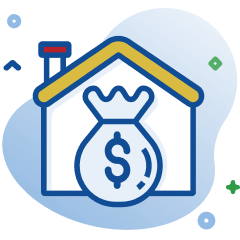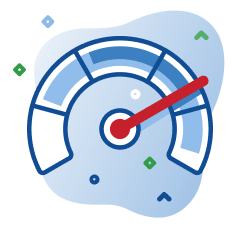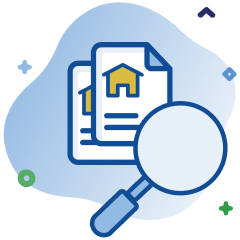
We'll arm you with the tools you need to make the right choice for you. From property reports to credit scores, let's work together to make your property dreams come true.

Dreaming of owning a property? Let's find out how much you can potentially borrow to put towards your new purchase.

Get the same credit information that lenders, telcos and utility providers use to assess your creditworthiness without impacting your actual score.

Buying, selling or being a nosey neighbour? Get valuable insights about the property, view recent sales and more.

Ready to buy or refinance? Apply online via a single application and we'll instantly check your eligibility for a home loan from a wide variety of lenders on our lender panel.

Our Meerkat Technology makes our comparison and application process a breeze, but sometimes you just need a helping hand! Our team of brokers and home loan experts are here to bring ease and expertise, and no question is too big or small; we're happy to help!
From the meerkats who made insurance and energy Simples comes a new way to compare and apply for a home loan. Welcome to Home Loan Heaven.
Say farewell to endless paperwork. In Home Loan Heaven you can compare from a range of lenders and then apply for a home loan completely online.
Our powerful lender-matching engine assesses your eligibility against the lender’s criteria. Instead of a laundry list of loans, you’ll see only those you’re eligible to apply for.
Keep your credit scores, property and suburb reports, loan comparisons and borrower scenarios all saved and easily accessible in your Home Loans Dashboard.
Our experts are on hand if you need help with your application, plus they also work hard behind the scenes with our panel of lenders to help you get a better deal and make the application process run smoothly.
Meet our brokers“My wife and I use Compare the Market for all our household expenses, and we’re in good company - over the years, they’ve helped millions of Australians find a better deal.”

It’s simple; there are thousands of home loan options in the market making it harder to figure out which loan is right for you. Rather than going with the first loan you find, you can go with a loan that suits your circumstances.
Whether you’re a first home buyer looking for a new home, an investor, or you’ve bought before and are looking to refinance, our free service can help you take the next step with confidence.
Finding a competitive interest rate has never been so simples!
Selling Houses Australia host, Andrew Winter explains how home loans work, and covers off some basics that prospective homebuyers need to know.

To get the most out of our comparison service, all you need to do is provide some basic details about your specific circumstances. Then we’ll show you a range of home loans products we think might be suitable for you based on the information you’ve given to us.
Whether you’re buying your first home, a new home, or looking to refinance, we’ve got a really simples way to help you find a home loan that suits your unique needs and circumstances!
Compare home loans
Thinking about switching home loans but unsure if you’re ready to take the plunge or not? We can help you figure out if it’s the right move for you, as well as answer some common questions you may have regarding refinancing.
Learn moreTo fix, or not to fix? That is the question, and it’s just one of many we may be able to help you with! Learn more about fixed rate home loans and their various pros and cons here.
Learn moreWhoever first said a change is as good as a holiday must’ve had a variable rate home loan! If you're weighing up your home loan options and considering a variable rate product, understand the key details with the help of our variable rate home loan FAQs.
Learn moreYour LVR can have a big impact on the ultimate cost of your home loan – but what is it in the first place, and how do you figure out what yours would be? Our LVR FAQs can help you figure out the answers.
Learn moreIf you’re hoping to land a foot on the property ladder and buy your first home, you’ll want to make sure you’re putting your best foot forward. You can arm yourself with all the information you need with the help of our dedicated info hub for first home buyers.
Learn moreStamp duty can tack a significant amount onto your home loan – but how do you figure out how much you might have to pay, or whether you’ll have to pay it at all in the first place? We’ve got the answers.
Learn moreIf you’re looking to buy a property, you likely won’t have enough money to cover the full purchase price. In this case, you can apply to a lender (e.g. a bank) for a home loan.
A home loan allows you to purchase the property with the money you’ve borrowed from the lender. You’ll need to repay this borrowed amount over the length of your loan (30 years is a common home loan length), and you’ll also need to pay interest on the amount owed, meaning the total amount you pay back to the lender will typically be significantly larger than the size of your home loan.
A home loan’s comparison rate takes things like fees and charges into account in order to calculate an interest rate that represents the ‘true cost’ of the loan. Financial institutions are legally required to display a comparison rate next to any advertised home loan interest rate to allow for easy comparison on the consumer’s end of things.
As the comparison rate can deviate from the advertised rate by a substantial amount, it can serve as an effective way of discerning a home loan’s value without having to do too much in-depth product research.
Banks and lenders are also required to display a comparison rate warning whenever they’re offering home loans to show customers how the comparison rate is calculated. The formula used to calculate comparison rates is standardised across all lenders and products.
One way to explain this is that a home loan is simply the amount of money you’ve borrowed to purchase your home, whereas a mortgage is the legal agreement that you have to sign before receiving your home loan, which essentially leaves you with a conditional right to own the home in question.
This means that, for example, if you couldn’t commit to your home loan repayments and ended up defaulting on your repayments, the lender has the legal right to repossess the property and sell it.
Even though a mortgage and a home loan technically describe different aspects of this legal encumbrance and associated financial product, you can’t really have one without the other, so it’s common to use the two terms interchangeably.
Home loans aren’t a one-size-fits-all product; there are numerous kinds of home loans that might be more or less suitable for you depending on your financial priorities and needs.
The most common types of home loans include:
Note that some of the above loan types aren’t mutually exclusive. For example, you could have an IO investment home loan, or a P&I owner-occupier home loan – there’s a difference between a loan’s purpose and the type of payments it requires.
You can speak to one of our home loan specialists if you’d like to learn more about what kind of home loan might be right for you.
Depending on how you look at it, there are two or three different kinds of home loan interest rates: There are fixed rate and variable rate home loans, and then there are also split-rate home loans, which combine the two. Each type has its advantages and trade-offs.
If you’re looking to crunch some numbers before you start looking for a home loan, our range of home loan calculators and tools are user-friendly and suited to borrowers of all kinds, from first home buyers to refinancers and property investors.
We’ve got calculators to help you at every stage of the homebuying process:
We also have a stamp duty calculator for every state and territory in Australia:
What makes for the ‘best’ or the ‘perfect’ home loan is as varied and diverse as the people taking out home loans all around Australia. There’s no way to name any one feature ’the best’ when it comes to home loans, as everyone has different needs and financial circumstances. This means that any given feature could be a valuable essential for one borrower, and a waste of money for another borrower.
However, with that all being said, the following features tend to be popular inclusions on home loans across the market:
If you’re unsure as to which features you might need on a home loan, you may want to speak to an expert or do your own research before beginning your home loan journey.
First time applying for a home loan? Thankfully, whether it’s your first home loan or your fifteenth, the home loan application process is largely the same, involving:
There’s no reason you have to go it alone when it comes to home loans. A mortgage broker can help you make more informed decisions and navigate some of the more complex aspects of the homebuying process.
Even if you feel you’ve got a fairly firm grip on the whole homebuying thing, enlisting the services of a mortgage broker could be prudent for a few reasons. Many brokers have built up strong relationships with certain lenders, meaning they’re well-placed to negotiate on your behalf and potentially secure you a better deal. Additionally, some home loan products are only available through a broker, so you open up a whole new range of home loan options by working with one.
Luckily for you, our experienced mortgage specialists are ready to help you with your home loan application whenever you’re ready. During your journey within our home loan comparison tool, you can ask to be put in touch with one of our mortgage specialists and they’ll be able to answer any questions you have about the products or process in front of you.
Home loan pre-approval involves your lender making a non-binding indication they would lend you the money needed to buy a house once you find it. Your lender will give you either unconditional or conditional approval to borrow up to a certain amount of money with which to buy a home.
This makes home loan pre-approval a useful thing to have in place, as it will give you a good understanding of your own buying/borrowing power. You can apply for home loan pre-approval from as many lenders as you’d like, but each separate application will put a small dent in your credit score, so it’s generally smart to limit the number of applications you make as much as possible.
You could potentially get an extra leg up when buying your first home thanks to the First Home Buyer Grant (FHOG) – a lump sum paid by your state or territory’s government towards the cost of your first home (given you meet the relevant eligibility criteria).
While the exact conditions and amounts will vary depending on where you live, you can typically be confident that you may receive a grant of up to $10,000 if you meet the relevant eligibility requirements.
The notable exception to the Grant is the ACT, which scrapped its version of the FHOG in 2019 and now offers stamp duty concessions to its first home buyers. This means instead of being given extra money to put towards your purchase, you’ll pay less money when it comes to that pesky property transfer tax.
While some home loans are billed as ‘low-fee’ or ‘fee-free’, there’s unfortunately no such thing as a truly fee-free home loan. Even if you avoid paying ongoing monthly fees on a ‘fee-free’ home loan, you’ll typically still have to cover a handful of upfront fees – and conversely, a home loan that advertises ‘no upfront fees’ will likely still charge monthly ongoing fees.
Some common home loan fees to be aware of include:
Make sure you read the key fact sheet for more information on any given loans’ fees and charges. While you typically can’t avoid paying home loan fees outright, you can shop around to find a loan with competitive fees that beat the competition and suit your financial priorities.
Lenders mortgage insurance (LMI) is a one-time fee that your lender may tack on to your home loan if your saved deposit is below 20% of the property value (meaning your LVR is higher than 80%). LMI acts as insurance for your lender, providing a financial buffer in the event that you can’t meet your home loan repayments.
Rather than being divvied up into fortnightly or monthly repayments, your LMI costs will typically be added to your loan amount in full. This in turn will drive up your regular home loan repayments, by both increasing the size of your principal and the amount of interest you’re paying on it.
It’s worth noting, however, that you may also be offered the option of paying your LMI upfront. While this won’t affect the cost of your LMI, it could help you pay less total interest over the life of your home loan.
Your loan-to-value ratio (LVR) is the amount you’re either wanting to borrow or have already borrowed, expressed as a percentage of your property’s value.
For example, if you were to borrow $400,000 in order to purchase a $500,000 property, you would have borrowed 80% of the property value, giving you an LVR of 80%.
It’s important to consider the LVR before you get the ball rolling on any home loan applications, as it can have a significant effect on the outcome of your efforts to get a home loan.
An unfavourable LVR may see you charged a higher interest rate, or even tank your application entirely and be denied by the lender.
We don’t always get it right the first time around – and that’s especially true for home loans, which are incredibly sensitive to rate changes (fixed rate home loans aside). A home loan that seemed affordable and value-packed yesterday could be a nightmare of a loan today, based on nothing more than an interest rate change.
Fortunately for homeowners around Australia, refinancing is an option. Refinancing involves ‘replacing’ your current home loan with a new, ostensibly better-value home loan, and is an option worth considering if your personal circumstances change, or simply because you think you could be getting better value from a different product or lender.
As always, you should be sure to compare a wide range of options before committing to one – you can begin your search using our home loan comparison tool.
If you’re looking to buy an investment property rather than a home, our property investing guide contains a wealth of valuable information including:
There’s no one best home loan in Australia, as everyone’s financial needs and wants are different. The same is true for banks; peoples’ circumstances and financial requirements are so varied that 50 different people could borrow from 50 different banks.
At the end of the day, the best mortgage for you is the mortgage that meets your financial priorities and needs. This will generally mean it a) has a competitive interest rate and fees and b) comes with high-value features you’ll use, that don’t cost an arm and a leg.
All that being said though, it can be difficult to know what a high-value loan looks like if you’re a first-home buyer or haven’t had to shop around for home loans in a while. But have no fear – our free, no-obligation home loan comparison service can help you on your search for the right home loan, from start to finish.
If you’re looking to buy a house, you might be interested in knowing which areas are the most affordable – and conversely, which suburbs are astronomically expensive.
Per CoreLogic’s most recent annual Best of the Best report, these were the cheapest and most expensive suburbs for buying a house in each Australian state and territory in 2022. CoreLogic’s research is based on property data provided by state and territory governments.
Source: Best of the Best report. 2022.
Stephen has more than 30 years of experience in the financial services industry and holds a Certificate IV in Finance and Mortgage Broking. He’s also a member of both the Australian and New Zealand Institute of Insurance and Finance (ANZIIF) and the Mortgage and Finance Association of Australia (MFAA).
Stephen leads our team of Home Loan Specialists, and reviews and contributes to Compare the Market’s banking-related content to ensure it’s as helpful and empowering as possible for our readers.
Let's get started making your property dreams a reality!
Click the button below to begin your home loan journey.
















